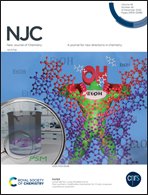Chalcogen controlled redox behaviour in peri-substituted S, Se and Te naphthalene derivatives†
Abstract
Cyclic and square wave voltammetry of (PhE)2peri-disubstituted naphthalene[1,8-cd]dichalcoganyls and acenaphthene[5,6-diyl]dichalcoganyls (E = S, Se, Te, 12 compounds) is reported. Mixed (E1 = Se, Te; E2 = Br, I) naphthalene[1,8-cd]halochalcoganyls were also investigated, as well as an exemplar bearing two PhS(![[double bond, length as m-dash]](https://www.rsc.org/images/entities/char_e001.gif) O) groups and another bearing one PhSe and one Ph2P(
O) groups and another bearing one PhSe and one Ph2P(![[double bond, length as m-dash]](https://www.rsc.org/images/entities/char_e001.gif) S) substituent. The voltammetry, in CH2Cl2/0.4 M [nBu4N][PF6] at both platinum and glassy carbon macro-disk working electrodes, shows two sequential chemically reversible and electrochemically quasi-reversible oxidation processes, and the lack of accessible reductions. Additional oxidations above +1.5 V vs. Fc+/0 have not been investigated in detail. In situ and ex situ EPR spectroscopy conclusively demonstrate that both anodic processes are 1e transfers; persistent radical cations could be generated for all the dichalcoganyls except when E1 = E2 = Te; for the latter case thermally stable dications are generated instead. The complex possible solution conformations of these compounds in 0, +1 and +2 charge states were modelled with DFT at the B3LYP-D3(BJ)/6-31+G(d) level of theory in a CH2Cl2 PCM continuum solution model and adiabatic ionisation energies calculated, which correlate linearly (R = 0.88) with the Ea1p values. Crystal structures of four solvolysis and hydrolysis products of the ditellurium dications are reported and were modelled computationally. Interpretative comparisons to unsubstituted naphthalene[1,8-cd]dichalcogenoles are reported and the crystal structure of naphtho(1,8-cd)(1,2-dithiolium) tetrafluoroborate has been obtained. This is the first structure reported for any salt of this cation radical. Electron transfer mechanisms of both the (PhE)2 and E2peri-disubstituted naphthalene series are correlated using a redox molecular orbital interpretative framework.
S) substituent. The voltammetry, in CH2Cl2/0.4 M [nBu4N][PF6] at both platinum and glassy carbon macro-disk working electrodes, shows two sequential chemically reversible and electrochemically quasi-reversible oxidation processes, and the lack of accessible reductions. Additional oxidations above +1.5 V vs. Fc+/0 have not been investigated in detail. In situ and ex situ EPR spectroscopy conclusively demonstrate that both anodic processes are 1e transfers; persistent radical cations could be generated for all the dichalcoganyls except when E1 = E2 = Te; for the latter case thermally stable dications are generated instead. The complex possible solution conformations of these compounds in 0, +1 and +2 charge states were modelled with DFT at the B3LYP-D3(BJ)/6-31+G(d) level of theory in a CH2Cl2 PCM continuum solution model and adiabatic ionisation energies calculated, which correlate linearly (R = 0.88) with the Ea1p values. Crystal structures of four solvolysis and hydrolysis products of the ditellurium dications are reported and were modelled computationally. Interpretative comparisons to unsubstituted naphthalene[1,8-cd]dichalcogenoles are reported and the crystal structure of naphtho(1,8-cd)(1,2-dithiolium) tetrafluoroborate has been obtained. This is the first structure reported for any salt of this cation radical. Electron transfer mechanisms of both the (PhE)2 and E2peri-disubstituted naphthalene series are correlated using a redox molecular orbital interpretative framework.



 Please wait while we load your content...
Please wait while we load your content...